Russian Education Export: Internal Internationalization
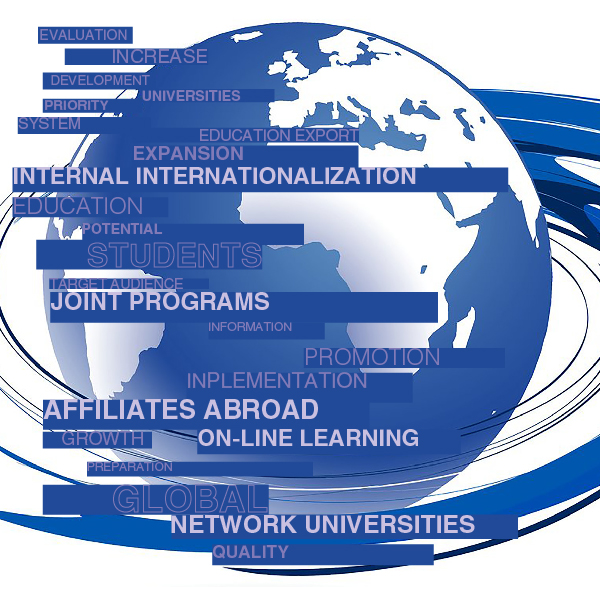
The target model of Russian education export implies the selection of methods for delivery of educational services, which could provide attaining the target indications of the national priority project on the development of the export potential of the Russian educational system. Such indications include a number of international full-time students in Russian educational institutions, an amount of non-budgetary funding, etc. The development and implementation of the model will be provided by the center of excellence for international offices of Russian educational institutions (RANEPA).
Taking into account four possible modes of service delivery listed by the World Trade Organization five key models of education export have been developed, namely: internal internationalization; joint educational programs; representative offices of Russian educational institutions abroad; online education; and network universities.
For its readers, the HED has prepared a series of articles on each model.
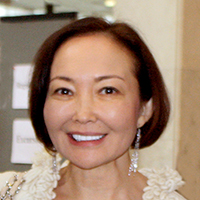
Gulnara A. KRASNOVA,
Chief Researcher, Professor of the Russian Presidential Academy of National Economy and Public Administration (RANEPA), Doctor of Philosophical Sciences
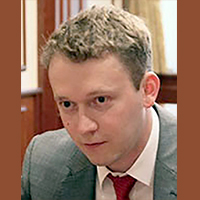
Andrei A. BAIKOV,
Vice-Rector for Master's and International Programs of the MGIMO University, Associate Professor, Candidate of Political Sciences

Ekaterina Ia. ARAPOVA,
Head of the Department for Expertise of Masterʼs Degree Programs of the MGIMO University, Candidate of Economic Sciences
Description and objectives
Internal internationalization implies recruiting international students for obtaining higher education at all the levels (pre-university training, Bachelorʼs, Masterʼs, post-graduate programs, advance training courses) in the full-time, part-time and mixed forms entirely in the territory of the Russian Federation, according to the WTOʼs consumption abroad mode of service export.
The economic effect of this model (export earnings) is constituted of funds raised from students as tuition fees as well as of funds left in the Russian economy during the period of their training (expenses on accommodation, meals, transport, mobile services, etc.).
The implementation of this model will facilitate the attainment of the key indications of the national priority project on the development of the export potential of the Russian educational system such as a number of international full-time students in the Russian higher education institutions and amounts of non-budgetary funds raised from Russian education export.
Internationalization in Russia
In Russia the greater part of commercial educational services to foreign citizens is provided by higher education institutions (HEIs). The full-time training brings the greatest incomes.
The main importers of the Russian educational services as of the 2015-2016 academic year were the CIS (63%) and Asian (28%) countries.
The number of international students of the Russian educational institutions is steadily increasing. The increase in 2015-2016 was 14% in relation to the total number of graduate and pre-university students and 12% in relation to the number of students in 2014-2015.
During the latest two years the numbers were increasing only due to students from the CIS countries (Kazakhstan, Tajikistan, Ukraine). The largest body of international full-time students in the 2015-2016 academic year consisted of Kazakhstan citizens (31.5 thousand people) as
in the previous year, China took the second place with 22.3 thousand, and Turkmenistan was on the third place with 14.0 thousand.
The proportion of foreign students whose study was funded by the Russian budget increased from 38.5% in 2014-2015 to 40% in 2015-2016. The increase in the number of international full-time students was observed mainly in the educational institutions belonged to the Ministry of Education and Science (by 12.8 thousand) and the Ministry of Healthcare of the Russian Federation.
The increase in the number of international graduate students, interns, post-graduate students, pre-university students and students of other categories was achieved mainly due to educational institutions located in the regional centers of the RF (totally by 12.2 thousand) as well as universities of Moscow and St. Petersburg (by 3.3 thousand).
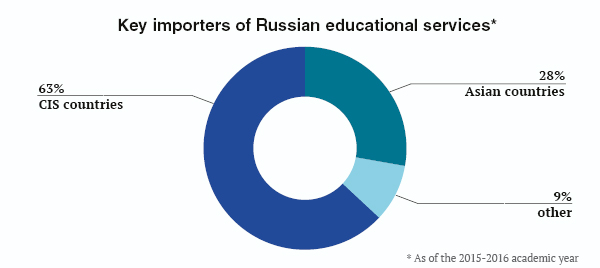
The number of Russian universities having international full-time students decreased in the 2015-2016 academic year in comparison with the previous year totally by 8.1% (64 HEIs), including non-state higher education institutions—by 17.3% (47 HEIs) and HEIs of the Ministry of Education and Science of the RF—by 5.7% (15 HEIs). It is related to the processes of merging universities and establishing larger educational institutions, closing diploma mills, terminating licenses for educational services, revoking state accreditation, prohibiting enrollment of new students.
Foreign citizens coming into Russia to get education prefer state higher education institutions. In 2015-2016 state universities had 96.6% of the total number of international students in the country, while non-state universities had 3.4% of them (4.5% in 2014-2015).
In the 2015-2016 academic year international students primarily chose engineering majors—45 thousand people or 22.4%, 37.3 thousand people (18.6%) chose medicine, and 28.2 thousand (14.1%)—economics.
In comparison with the previous year the most significant increase was in the number of students majoring in medicine (by 5.8 thousand) and engineering (totally by 5.2 thousand) especially in metallurgy, machine-building and material science—by 1.8 thousand as well as in geology, exploration and development of natural resources—by 1.1 thousand, in natural and exact sciences—by 2.3 thousand. At the same time the number of international students majoring in economics and social sciences decreased, by 0.8 thousand and 0.5 thousand respectively.
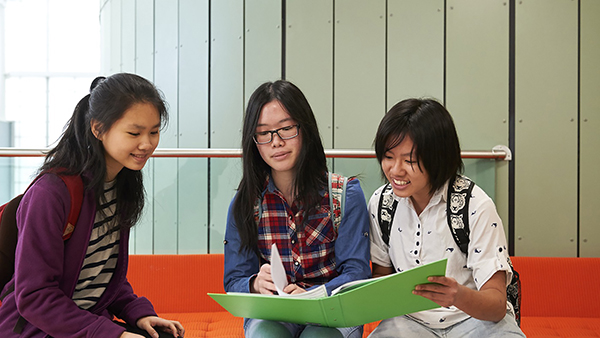
Russian universities aiming to recruit prospective international students for study in the territory of the RF use different methods of attraction, both traditional and new:
- arrangement of and participation in olympiads, contests, career-guidance events (live and remote) hosted by the RF or foreign countries, partner institutions and universities for the attraction of gifted and motivated international students;
- participation in educational exhibitions and fairs;
- arrangement of recruiting events including summer innovative camps for schoolchildren, summer and winter schools, etc.;
- on-line recruiting;
- opportunities for employment of international students;
- posting information on educational programs on the university websites and the national portal “Education in Russia” (ru.education.mon.gov.ru), commercial educational portals, and cooperation with international recruiting agencies;
- dissemination of information on educational programs delivered by Russian universities through Russian embassies and representative offices of Russian governmental institutions abroad such as Russian schools, culture centers, the Federal Agency for CIS Affairs, Compatriots Living Abroad and International Humanitarian Cooperation, etc.;
- development of awareness about educational programs delivered by Russian universities through cooperation at the level of Ministries of Education and Science, adding of Russian universities in the lists of universities approved by the Ministries of Education of different countries of the world, in the lists of educational institutions included in the national scholarship programs;
- dissemination of information on educational programs delivered by Russian universities through the associations of international graduates from the Russian (Soviet) higher education institutions;
- promotion through search systems, social media and free educational portals (Facebook, Twitter, G+ and Youtube in the Russian and foreign languages), websites of partner-universities, portals of international educational consortiums and professional associations;
- active marketing of educational programs in the mass media and on the key relevant informational platforms as well as development of awareness about educational programs in the mass media and social networking websites.

Internationalization in the world
The size of the international market of educational services is about US$200 billion. In the coming 2017-2020 years annual growth rates of the educational services market are expected to be 17%, as a result by 2020 this market can increase to US$252 billion.
Over 50% of the total number of foreign citizens studying abroad are the students of the USA, UK, Australian, Canadian, French, German, Japanese universities. Nevertheless, in the recent years the proportion of these countries in the world education export tends to decrease, while the proportion of China, the Republic of Korea, Malaysia and Singapore is growing.
About 30% of international students getting education abroad come from four countries: China, the Republic of Korea, India, and Germany. The growth rates of education import are rather high in Vietnam, Iran, Malaysia, and Saudi Arabia. The most popular majors here are business and management, engineering, the humanities and art, social sciences and law.
The model algorithm
1. The approach to the internal internationalization model: recruiting international students to the educational programs delivered by Russian universities in the Russian language.
The target audience of this model is Russian-speaking international students first of all from the CIS countries, which constitute the Russian-speaking world and traditionally have a positive attitude to Russian education and brand awareness of Russian universities, as well as from the third world countries.
2. The approach to the internal internationalization model: recruiting international students to the educational programs delivered by Russian universities in foreign languages.
The target audience of this model is predominantly foreign students who do not speak Russian. The application of this model sets some requirements like a high level of teachersʼ language skills and a higher qualification level of administrative staff (language skills, qualification in migration law, etc.).
The desirable target audience
When choosing the most desirable target audience that is a country of origin of international students attracted to Russia, it is necessary to take into account the following factors:
1. A traditional, historically developed interest in Russian education: it appears as a relatively high proportion of international students from this country of origin and comparatively high rates of the annual growth.
2. An increased demand for educational services in those majors where Russia enjoys higher competitiveness and internationalization.
Globally, the countries of the Asian region take the first place as in the 2015-2016 academic year they had 28% of the total number of international students in the world. Namely, China had 13%, India—4.5% (though the proportion was rather small, the increase rates of international students from India turned out the fastest—28% in relation to the level of 2014-2015), Vietnam had 3%, however with its proportion decreasing, this country was followed by Malaysia and Mongolia also with declining numbers.
Among the West European countries the leaders are Italia, France, and Germany, though over the recent years the first two countries have had descending trends.
As for Africa (except the northern part of the continent), Nigeria and Angola have the largest numbers of students pursuing education at Russian universities. In Latin America the first place belongs to Brazil with a growth rate of 13% which is outpacing the average rate of 10%.
With this in mind we can state that the ten most desirable countries supplying international students to Russia are China, India, the Republic of Korea, Malaysia, Indonesia, Vietnam, Mongolia, Brazil, Angola, and France.
Risks and opportunities
The potential risks include:
- intensification of competitive activities by the worldʼs major economies competing for educational services markets;
- political, military and economic disruptions in the countries being primary receivers of Russian educational services, depreciation of the national currencies in the CIS, Asian, and African countries;
- tightening of Russiaʼs migration policy in relation to international students in the context of terrorist threats;
- extension and escalation of sanctions against Russia that can affect its image abroad and its attractiveness as a provider of educational services;
- a decrease in the number of people speaking Russian and in the number of educational institutions teaching Russian in the foreign countries;
- a decrease in the number of school-leavers in some CIS countries and in most European countries due to demographic reasons;
- an increase of living expenses in Russia that reduces its economic attractiveness as a country of study;
- insufficient language skills of teachers and administrative staff at Russian universities;
- the insufficient infrastructure of Russian universities, its inadequate level for attraction of international students;
- low tolerance of the Russian population toward international students from certain countries;
- the increasing number of international students might result in formation of expat communities, growing distrust by the native people, and social disruption.
At the same time there are important opportunities:
- Russiaʼs activities aimed at integration with foreign countries in the different regions of the world, it includes the Shanghai Cooperation Organization, the Eurasian Economic Community, and the BRICS countries;
- Russiaʼs participation in the Bologna process which promotes the dialogue with the EU member states and the East European countries covering the issues of harmonization and partnership in education as well as Russiaʼs participation in UNESCO, ATEM, ASEAN, ASEM and other organizations;
- a gradual decrease of the resource-based component of Russiaʼs economy and a growth of the knowledge-based economy in the country, that can be of special interest for foreign investors and prospective students;
- an essential interest of foreign countries to academic mobility programs for their citizens (for example, Denmark, Japan) aiming at gaining international experience;
- an increase in the number of school-leavers in some CIS countries;
- de-escalation of tensions in Russiaʼs relationships with foreign countries, development of privileged partnerships and friendly relationships with them, which can ease visa and migration regulations;
- instabilities of the world economy and other critical conditions, as a rule, cause outflows of young hopefuls from the country, including those having a sufficient consumer potential from the target audience;
- spread of influence of international graduates from the Russian educational system on the promotion of its positive image abroad and recruiting prospective students for studying in the Russian educational programs;
- improvement of the living standards and educational infrastructure at the Russian university centers that can attract more international students;
- improvement of education quality as a result of universitiesʼ competitive practices aimed at recruiting international students, introduction of educational programs and modules in foreign languages into the educational process, arrangement of on-the-job and project-oriented training for international students, interns, and post-graduate students.